使用带周期跳跃方案的自适应相场法研究功能分级材料中的疲劳裂纹生长
IF 4.7
2区 工程技术
Q1 MECHANICS
引用次数: 0
摘要
功能分级材料在调整组成材料的体积分数以满足特定设计要求方面具有多功能性。然而,这种定制往往会在裂纹顶端引入模态混杂性,从而给采用离散方法预测循环加载下的断裂带来挑战,而且传统的相场断裂模型计算成本高昂。为了解决这些问题,本文介绍了一种带有周期跳跃方案的自适应相场断裂公式,以优雅地预测功能分级材料中疲劳裂纹的成核和生长。在此框架内,使用 Mori-Tanaka 均质化方案估算某点的有效属性,同时通过加入额外的疲劳退化参数来捕捉循环载荷导致的裂纹增长。此外,通过自适应网格细化和显式循环跳转方案,提高了拟议框架的计算效率。自适应细化方案利用从位移解决方案和相场变量中得出的误差指标。自适应细化方案与高效的四叉树分解相结合,可生成分层网格结构。四叉树分解产生的悬挂节点通过多边形有限元方法得到有效处理。根据文献报道的实验和数值结果,对提出的框架进行了验证。此外,我们还研究了各种材料分级方向的抗疲劳裂纹生长能力,从而获得了宝贵的见解,并确定了具有高抗疲劳能力的功能分级材料。本文章由计算机程序翻译,如有差异,请以英文原文为准。
Fatigue crack growth in functionally graded materials using an adaptive phase field method with cycle jump scheme
Functionally graded materials provide versatility in adjusting the volume fractions of constituent materials to meet specific design requirements. However, this customization often introduces mode-mixity at the crack tip, posing challenges in predicting fracture under cyclic loading with discrete approaches and computationally expensive with conventional phase-field fracture models. To address these issues, this paper introduces an adaptive phase-field fracture formulation with cycle jump scheme to elegantly predict fatigue crack nucleation and growth in functionally graded materials. Within this framework, the effective properties at a point are estimated using the Mori–Tanaka homogenization scheme, while the crack growth due to cyclic load is captured by incorporating an additional fatigue degradation parameter. Moreover, the computational efficiency of the proposed framework is improved through an adaptive mesh refinement and explicit cycle jump scheme. The adaptive refinement scheme utilizes an error indicator derived from both the displacement solution and phase-field variable. The adaptive refinement scheme is integrated with efficient quadtree decomposition, which generates a hierarchical mesh structure. Hanging nodes resulting from the quadtree decomposition are efficiently handled using a polygonal finite element method. The proposed framework is validated against experimental and numerical results reported in the literature. Furthermore, we investigate the fatigue crack growth resistance across a broad range of material gradation directions, gaining valuable insights and identifying functionally graded materials with high fatigue resistance.
求助全文
通过发布文献求助,成功后即可免费获取论文全文。
去求助
来源期刊
CiteScore
8.70
自引率
13.00%
发文量
606
审稿时长
74 days
期刊介绍:
EFM covers a broad range of topics in fracture mechanics to be of interest and use to both researchers and practitioners. Contributions are welcome which address the fracture behavior of conventional engineering material systems as well as newly emerging material systems. Contributions on developments in the areas of mechanics and materials science strongly related to fracture mechanics are also welcome. Papers on fatigue are welcome if they treat the fatigue process using the methods of fracture mechanics.

 求助内容:
求助内容: 应助结果提醒方式:
应助结果提醒方式:


